new posts in all blogs
Viewing: Blog Posts Tagged with: contracts 101, Most Recent at Top [Help]
Results 1 - 25 of 40
How to use this Page
You are viewing the most recent posts tagged with the words: contracts 101 in the JacketFlap blog reader. What is a tag? Think of a tag as a keyword or category label. Tags can both help you find posts on JacketFlap.com as well as provide an easy way for you to "remember" and classify posts for later recall. Try adding a tag yourself by clicking "Add a tag" below a post's header. Scroll down through the list of Recent Posts in the left column and click on a post title that sounds interesting. You can view all posts from a specific blog by clicking the Blog name in the right column, or you can click a 'More Posts from this Blog' link in any individual post.
As a children's author, I have the privilege of reading to kids, mostly in schools and libraries, and I always start by telling them that my poems all come from my imagination. I continue by saying that they all have imaginations too, as good was mine or as anyone else's. That gets them thinking, and listening a bit more sharply.
During the reading of my poems, I ask for questions, a part I always enjoy because I never know what will come at me. What is most frequently asked is, where do I get my ideas? I remind them that I use my imagination but that
I am listening and looking and smelling the world around me for ideas or phrases or situations or animals or colors or jokes that can spark the beginning of a poem. By going towards life I am rewarded because life then comes back to me with buckets of stimulation.
I tell them that on my book jacket notes, it says: "'He spends a lot of time looking out the window,' reads one of Robert Forbes' report cards."
Daydreaming is healthy, and in our busy-every-minute high-tech lives, it's good to slow down and get out of the electronic bubble we have all put ourselves into.
We talk about word choice and how it is the vehicle of writing, while imagination is the perpetual fuel for it.
Poetry has many forms, and whatever they feel is right for them is what they need to use.
But poetry has rules that can be demanding too, and those rules make it more fun because of the challenges they present. I like rhyming, which can be hard. I also use meters, so there is rhythm to my poems. While metered rhymes can be difficult, I love the journey they take me on. I don't always know where I am going to end up and sometimes I know where I want the poem to go but I don't know how I will get there.
I wouldn't have it any other way!
In the end, I write poems to please myself, and I hope they please others. By reading to children, I hope to stimulate them to read poetry and to try to write some themselves.
I am scattering seeds in the belief some will sprout and scatter more seeds down the line.
Robert L. Forbes is President of lifestyle magazine ForbesLife and the author of the poetry collections Let's Have a Bite! and Beastly Feasts!
It's a huge honor for me to share the words of Paul B. Janeczko today, a poet I discovered in college and whose work I used in my classroom for years.
I didn't start out to be a poet. I started out as a kid in New Jersey who had two major goals in life: 1) to survive one more year of delivering newspapers without being attacked by Ike, the one-eyed, slobbering, crazed cur that lurked in the forsythia bushes at the top of the hill; and 2) to become more than a weak-hitting, third-string catcher on our sorry Little League team. I failed at both.
Had I announced at the dinner table, “Mom, Dad, I’ve decided to be a poet,” my parents -- particularly my mother -- would have been thrilled. In truth, they would have been thrilled that I’d decided to be anything other than the top-40 disk jockey, Edsel salesman, or bullpen catcher that I constantly yammered about becoming in grammar school. But at that point in my life -- as an affable kid who endured hours sitting in a desk whose design, I was convinced originated in a 15th-century Spanish dungeon -- poetry meant no more to me than 1066 or George Washington’s wooden teeth. You can tell, I suspect, that as a student, I did not have what you might call an “inquisitive mind.” The only time I was “gifted” was on my birthday and on Christmas.

My path from grammar school to high school teacher to poet gave me many opportunities to heed my internal GPS when it declared, “Recalculating.” For some inexplicable reason (dare I call it a blessing?), poetry was a constant companion along the way, whether I was teaching or writing my own poems. Whenever I worked with kids and poetry, I have wanted the kids to feel that all poems have a purpose, described well by Jonathan Holden:
“to give shape, in a concise and memorable way, to what our lives feel like . . . Poems help us to notice the world more and better, and they enable us to share with others.”
And today, with civilization seemingly destroying itself piece by piece, we all need to share. That’s what poets do. That’s what I try to do with my books. Isn’t that what we all try to do with words? I want young readers to feel that with each collection. Every poem in them is a sharing. My hope is that my readers will carry on that sharing.
As for me, although I never even sat in an Edsel or played ball above the Little League level, I did become a reader and writer of poetry. I consider myself lucky, given my staggering lack of interest and effort in school, not to mention the poetry I was expected to read. But kids don’t need to rely on luck to become readers of poetry. Exciting books of poetry are available. I hope parents and teachers share our love of poetry with kids. And let’s give them a chance to share their love of poetry with us. And, when we are touched by a good poem, we may recall the words of Stanley Kunitz, who said that if you listen hard enough to poets,
“who knows--we too may break into dance, perhaps for grief, perhaps for joy.”
Paul B. Janeczko aspired to be the teacher he never had, when he decided to pursue a career as a high school language arts teacher. From his own days as a student, Paul was obsessed with poetry of all kinds, and as a teacher he wanted to spread his own love of poetry to young people. Today, Paul Janeczko is better known as a writer, poet and anthologist.
Click through to sign up for the National Poetry Month giveaway!
**Congratulations to Donna MacDonald, winner of Lee Wardlaw's WON TON, A CAT TALE TOLD IN HAIKU. Please contact Lee with your shipping address. **
Acrostic poems are written by taking the letters of a word or name and using them as the first letter of each line of the poem. I like to use acrostics in both in my writing and in my teaching, even outside the language arts classroom. In social studies for example, acrostic poetry can be a very useful way of exploring a topic. Sometimes I give students an exercise to write an acrostic poem about Canada. Most of them end up starting with the word “cold”!
After starting with this students have the makings of an essay outline with paragraphs about Canadian climate, vegetation, history, culture (we are known worldwide for saying “I’m sorry” a lot), political system, and a conclusion.
*A printed dictionary is essential for this exercise. All the more reason to do it. Kids should use dictionaries more often.*
Both in and out of language arts, there are several ways of approaching the writing of acrostic poetry. Say we wanted to write a poem about “Mothers”. We might write something like:
This is the simplest kind of acrostic – basically it’s just a list of adjectives that fit the word you choose. Another thing to do is to use short phrases or sentences instead of single words.
Make our breakfast
Open their hearts
Think of us first
Hold us tight
Enjoy our successes
Read to us
Say “I love you” to us every day.
Now we have a more detailed description of mothers. This poem talks about the things mothers do for us. But that’s not the end for acrostics. Another approach is to go back to single words, only this time all the words together make sentence about your word. Like this:
Now finally we can go back to our phrases and sentences. Only this time we can make them connected into one idea. Kind of like this:
Maybe we don’t appreciate that they’re the
Ones who make us who we are
They selflessly, carefully
Help us grow. To them
Every child is like a seed in a flower garden.
Rising up, our petals open in their
Sunlight
The great thing about using acrostic poetry in the classroom is that students can write about any topic that interests them, and at a level they are comfortable with. More advanced students can write with complete sentences while struggling students will get a sense of accomplishment from completing the simpler word list form.
Even within a topic, students can narrow their focus to suit their interests. Writing about Canada, some students might focus on sports:
While some might prefer to focus on wildlife.
Caribou
And moose
Narwhal
And seals
Ducks
And Canadian geese.
We’d all love to get more poetry into the classroom, as well as new ways of approaching curriculum materials in general and the development of writing skills in particular. Acrostic poetry is a great way of doing all these things.
As writers and poets acrostics can help us to get to know our characters or explore our themes. Certainly as a verse novelist, a simple acrostic can sometimes salvage an otherwise unproductive day.
And we all have those.
Gabrielle Prendergast is the writer of the feature film HILDEGARDE, starring Richard E Grant. HILDEGARDE was also published as a novel by Harper Collins Australia. She wrote for the cartoon series Gloria’s House and Fairy Tale Police Department and worked on the drama series White Collar Blue. Her middle grade novel, WICKET SEASON was published in the Spring of 2012 with Lorimer Publishers. AUDACIOUS and its sequel CAPRICIOUS will be published by Orca Books in 2013 and 2014 respectively.
Gabrielle is also a creative writing teacher and mentor specializing in helping gifted young writers (11-21), reluctant writers of all ages and pre-literate writers up to age 7.
.jpeg?picon=2982)
By: Caroline Starr Rose,
on 4/8/2013
Blog:
Caroline by line
(
Login to Add to MyJacketFlap)
JacketFlap tags:
Grooks,
Piet Hein,
Shelf Employed,
poetry,
Lewis Carroll,
Henry Wadsworth Longfellow,
jabberwocky,
national poetry month,
poetry in the classroom,
memorizing poetry,
Lisa Taylor,
Add a tag
I’ve known the birthdate of a casual acquaintance for 30 years, yet I don’t know that of a dear friend, only that he received his first driver’s license on the anniversary of Pearl Harbor Day. Why? The juxtaposition of a “day of infamy” and the possibilities of a new driver’s license struck a wry chord in my teenaged brain. As for the acquaintance, he was born on the same date as the fictional Bilbo Baggins, someone with whom I am much closer. The reasons that I can recite three poems from memory after more than thirty years are as divergent as the poems themselves. There are no lessons for teachers here. I learned them through osmosis, spitefulness and happenstance, in much the same way that I remember birthdays.
In fifth grade, I had a teacher that I neither liked nor disliked. In fact, I remember only one thing about her. She had a haughty, old-school manner of speaking - except for one day, when her detached manner slipped away as she recited Henry Wadsworth Longfellow’s “The Arrow and the Song,”
I shot an arrow into the air,
It fell to earth, I knew not where;
For, so swiftly it flew, the sight
Could not follow it in its flight.
I breathed a song into the air,
It fell to earth, I knew not where;
For who has sight so keen and strong,
That it can follow the flight of song?
Long, long afterward, in an oak
I found the arrow, still unbroke;
And the song, from beginning to end,
I found again in the heart of a friend.
It was the second verse that caught in my mind and my own thoughts soared like the song, out of a dreary 5th grade classroom and into the limitless sky. Later, I taught myself the rest of the verses. I’ve been able to recite it ever since. I like it still.
In Junior High School, I had an Algebra teacher that I disliked a great deal. In the summers, he was a barker on the boardwalk at the Jersey Shore. He was a wise guy in a tough school. So was I. One day he announced that anyone who could memorize and recite Lewis Carroll’s “Jabberwocky” to the class on a pre-ordained date, would be exempt from taking an Algebra test. After securing a copy of the poem, I realized what a challenge it would be. Despite my disinclination toward public speaking and the difficulty in memorizing this poem in particular, he had thrown down the gauntlet and I would pick it up.
Jabberwocky
'Twas brillig, and the slithy toves
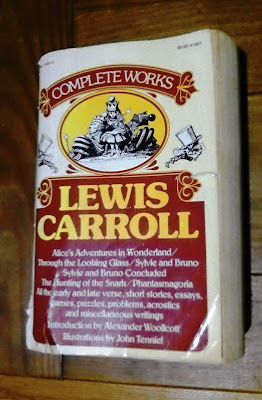 Did gyre and gimble in the wabe;
Did gyre and gimble in the wabe;
All mimsy were the borogoves,
And the mome raths outgrabe.
"Beware the Jabberwock, my son!
The jaws that bite, the claws that catch!
Beware the Jubjub bird, and shun
The frumious Bandersnatch!"
He took his vorpal sword in hand:
Long time the manxome foe he sought—
So rested he by the Tumtum tree,
And stood awhile in thought.
And as in uffish thought he stood,
The Jabberwock, with eyes of flame,
Came whiffling through the tulgey wood,
And burbled as it came!
One, two! One, two! and through and through
The vorpal blade went snicker-snack!
He left it dead, and with its head
He went galumphing back.
"And hast thou slain the Jabberwock?
Come to my arms, my beamish boy!
O frabjous day! Callooh! Callay!"
He chortled in his joy.
'Twas brillig, and the slithy toves
Did gyre and gimble in the wabe;
All mimsy were the borogoves,
And the mome raths outgrabe.
I memorized and recited that poem. I became interested in the works of Lewis Carroll. I asked for a book of his collected works for Christmas. I read them all, and I’ve never forgotten the poem. There are seldom opportunities for speaking it aloud, but imagine my surprise and delight when I saw Tim Burton’s Alice in Wonderland. I smiled to myself, knowing that I was likely the only one in the theater who knew that the plot of the movie was not the book, Alice in Wonderland, but the poem, “Jabberwocky.” I knew the ending before the movie barely begun.
Chance brought me to the last poem in my verbal repertoire. As a librarian, I know not to judge a book by its cover - but I still do. As a teenager, I was perusing my local bookstore when I came upon a most appealing little book. It was cute, it was yellow, and from its cover, the pensive little man pondering the universe called out to me. It begged to be read. The book was Grooks by Piet Hein, a Danish mathematician, inventor, scientist, designer, and yes, poet. Grooks, I discovered, were a style of poem invented by Hein, rhyming aphorisms, really. They were clever and succinct, and I loved them. For over 30 years, one Grook has stayed with me. I recite it aloud - to myself, to my children, to whoever is near whenever things don’t go as they’ve been carefully planned.
ON PROBLEMS
Our choicest plans
have fallen through,
our airiest castles
tumbled over,
because of lines
we neatly drew
and later neatly
stumbled over.
And so there are three; and more diverse they could not be: “The Arrow and the Song,” “Jabberwocky,” “On Problems.” Teachers and poets, take heart. The mind is a curious thing. You may not know what will unlock the mind’s door to receive your poems, but you can ensure that they keep knocking. Sooner or later, one (or three) will get in.
In Room 407 each fall, I begin the first couple of class meetings with a poem. Perhaps I start off the class kind of quietly bringing everyone in the room into the moment I launch into a reading of James W. Hall’s “Maybe Dat’s Your Pwoblem Too,” Elmer Fudd-like impediments and all.
And poetry can be about subjects like self-identification and the difficulty that comes of attempting to “burn our suits.” And if that suit is sewn together with a hatred of poetry, you can easily find your kin in just about any given English classroom as you might a swoosh on several pairs of sneakers.
The next class meeting, I might mysteriously roll up a piece of newspaper walking up and down the rows asking for a volunteer for a poem I would like to share. Students in Room 407 look at me a little sheepishly as a 6’3” 250 pound man asks for volunteers while he swats his own palm with a rolled up newspaper. It’s very early in the year, you must understand. This is a time of great risk.
And opportunity.
To introduce poetry.
And when I have my volunteer, I share Taylor Mali’s “Falling in Love is Like Owning a Dog” from his poetry collection, What Learning Leaves. When the moment comes that the whole class realizes that this might not be an act and a classmate might really get a rolled-up newspaper to the nose. . .
Well. . .we’ve hooked them.
Early on.
Onto poetry.
As the lead learner, I recognize that an appreciation of poetry must begin within those very first days of class vs. the tradition of approach of waiting until April to find out that most of the students hate poetry.
Hate poetry.
My students come to me hating poetry.
As a lead learner, you can almost see the faces go blank upon the mention of the word “poetry” like an electronic device that has just gone into its default rest mode.
As a poet, I cannot help to feel a little heart-broken. Poets are like this. We tend to wear embellishments—to include our hearts—upon thin gossamer sleeves. We are fragile when we encounter something as anti-poetical as “hate.” I cannot even bring myself to say something teacher-like such as “Well. . .I’ll tell you what. . .I’ll love it and you learn it.”
This is not what a learning community looks like. And poetry tends to shrivel up and die, pressed like dried leaves between the pages of textbooks that will be stacked in piles at the end of the school year. This keeps the poems preserved for another group in the off chance that perhaps they will appreciate them.
But this is not where poetry lives. At least not for this poet.
This might be because I have yet to become anthologized. When this day comes, I may have to finally purchase a textbook.
Wait. . .they would tell me first, right? I want to make sure that I have a good headshot vs. one of those artist renderings of the poet in the thumbnail by the poem.
Ever notice that the questions related to the poem designed to make sure that students have read the poem take up more space upon a textbook page than the poem itself.
I hate that.
And I will give a nod to the canon as a poet and as a scholar. Students need to know about Whitman, Frost, Dickinson, Hughes, Giovanni. . .
But when it comes to bringing poetry to an audience that brings a predisposition of dismissal of poetry in their toolboxes, I go with performance and spoken word poetry every time.
One of the poems we have had great success (if success is measured by the number of students that requested a repeat of the poem or those same students who sat with heightened attention during the TED Talk that showed the actual poet reading his piece. . .or the number of students that went home and favorited the poem at Twitter or posted it to their Facebook and Pinterest profiles) with this year is Shane Koyczan’s “To This Day.” The internet community has embraced this spoken word piece as a sort of anthem for the bullied and the animated version of the poem has gone viral in the past couple of months since its initial posting.
I wonder if students make their “hatred of poetry” manifest in their walking up to the front of the room to gather up tissues for one another as they wipe their ironically-detached eyes from the humidity in the room. It’s either poetry or pollen counts. And since the day we shared Shane’s piece in the room was the coldest day of the season in southern Indiana, I would give poetry a point here. Be sure to watch Shane’s TED Talk to see how he seamlessly moves into his performance piece after a bit of monologue. Stick around until the end to see the humble response of this poet to an audience of professionals in their respective fields who honor Shane’s poem with a standing ovation.
U. S. Poet Laureate Ted Kooser once intimated that poetry isn’t something one could trade for a tank of gas so poetry is very little use to the public. And I agree with this appraisal of the genre, until we unpack the genre for what is most useful to us. The need for succinct connection that—sometimes—only poetry can provide.
In Room 407, we have the following DVDs in our library: LOUDER THAN A BOMB, TAYLOR MALI AND FRIENDS, THE UNITED STATES OF POETRY, Various Individual World Poetry Slam DVDs, and a host of other poetry related documentaries and offerings. I encourage my students to think about poetry they have only read before and to give that same poetry a turn in an audio format. You’d be surprised how many students who say they at least like Shel Silverstein have never HEARD Shel Silverstein. We make sure students hear Shel in Room 407.
My students come to at least a “like” of poetry because their teacher is a poet. And I don’t think that every lead learner has to be a poet in order to appreciate poetry, but can you at least sense that it goes a long way to demonstrate to your learning community that you follow the current trends of poetry vs. filing away the same pieces we might have shared out of a sense of tradition?
By the time you have an opportunity to read this post, Room 407 will have been recognized as a Spotlight Feature on the Mattie J. T. Stepanek Foundation website. Mattie is another poet we introduce our students to early on in the year. Mattie’s Heartsongs series of books brings many of our students back to poetry. We are super excited to not only rekindle a love for poetry in the room, but to be part of a larger community of peace and poetry that honors a poetic voice taken from us far, far too soon.
I promised Caroline that this would not go long. . .and look. . .I got all excited here. . .I would like to end the post with a list—at least—of cannot miss poems that we have shared in Room 407:
“Weather is Here; Wish You Were Beautiful” by Rachel McKibbens (Pink Elephant)
“Where I’m From” by George Ella Lyon (from THE UNITED STATES OF POETRY)
Paul W. Hankins teaches 11th grade English and AP ENGLISH LANGUAGE AND COMPOSITION at Silver Creek High School in southern Indiana. A presenter on education topics at the local, regional, state, and national level, Paul’s passion is for kids and books and bringing the two together. Paul lives with his wife, Kristie, children Noah (12) and Maddie (10), two cats (Butterfinger and KitKat) and a hoplessly-devoted dog (Mia). You can friend or follow Paul at Twitter and Facebook. He is very easy to find on the internet under the name, Paul W. Hankins.
Click through to sign up for the National Poetry Month giveaway!
There will be two concurrent features on the blog next month. We will continue with The Lucy Maud Montgomery Journals Read Along, with the introductory post running April 1 and the discussion post April 29. We'll take off the month of May and resume reading Volume III in June.
If you're interested in learning more, click through to the idea behind the read along and the reading schedule.
The rest of April will be devoted to National Poetry Month. There will be a variety of posts from poets, authors, readers, and teachers talking about their experiences with poetry. And there will be a really fun giveaway. More on all this in the days to come.
Here's a Lucy Maud Montgomery quote that nicely ties the month together:
I love best the poets who hurt me -- who offer me the roses of their thoughts with the sharp thorn among them, piercing to the bone and marrow. When in reading a poem I come across some line or couplet that thrusts itself into my heart with a stab of deadly pain -- then is my soul knit unto the soul of that poet forevermore. Browning hurts me worse than any poet I have ever read -- and so I love him most.
.jpeg?picon=2982)
By: Caroline Starr Rose,
on 5/9/2012
Blog:
Caroline by line
(
Login to Add to MyJacketFlap)
JacketFlap tags:
poetry,
teaching,
Laura Ingalls Wilder,
Kansas,
book club,
poetry in the classroom,
study guide,
novel-in-verse,
May B. Book Club Kit giveaway,
Batam Island International School,
Add a tag
Remember the May B. Book Club Kit Giveaway? Here's a story from one of the runners-up. Sarah Baldwin teaches at the Batam Island International School in Batam, Indonesia. Her students (first through seventh grade) have just finished reading May B. I couldn't resist posting her lovely email and the pictures that accompanied it:
Our classroom journey through the world of May B has been an enlightening adventure!
 |
| Marking out the dimensions of a soddy |
The children excelled at writing up and presenting reports on the flora and fauna native to Kansas. They really enjoyed marking out the inside of a soddy home and felt cramped just imagining the dirt walls, ceiling and seemingly endless snow outside.
Your vocabulary words were accessible and insightful, especially to those who have never seen the Midwest of the United States. Most of all, the students enjoyed the short video clips of you describing
soddy homes and
poetry. Thank you for preparing those for us!
Thank you for providing a wonderful
Study Guide on which we could hang all our ideas and questions surrounding May B. As a teacher, I was gratified to read the students' responses to the the KWL Chart: Life on the Prairie. They definitely remembered the fact that buffalo chips weren't like Dorritos and teachers could be as young as 15 years old! I really enjoyed hearing students' insights into the discussion questions.
May B was just as much a gift to me as it was to my students. I grew up wanting to be La
Congratulations to swag pack winners, LynNerd and bfav, and THE YEAR THE SWALLOWS CAME EARLY winner, Rebecca Kiel.
Over at the Class of 2k12, we're trying to come up with helpful, new ways to give back to readers, teachers, librarians, and booksellers. With that in mind, I've created a very amateur video I'm calling Poetry 101.
What is it about dinosaurs that so captures the attention of children? Is it their size? The mystery? Or perhaps it's the fact that every time a new skeleton, nest, or coprolite is unearthed we learn something new. So, in celebration of our longstanding fascination with dinosaurs, here are some poetic connections.
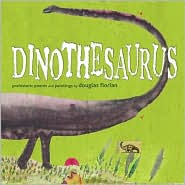 Dinothesaurus: Prehistoric Poems and Paintings
Dinothesaurus: Prehistoric Poems and Paintings, written and illustrated by Douglas Florian, is a collection of 20 poems chock full of information about dinosaurs. Each double page spread contains an illustration and a poem. The illustrations were done with gouache, collage, colored pencils, stencils, dinosaur dust, and rubber stamps on primed brown paper bags and are full of interesting little tidbits. For example, the pages for the poem
Iguanodon has a female dinosaur (Iguano-Donna) who is wearing bracelets and a pearl necklace. Before, during, and after reading the accompanying poems they beg to be looked over carefully. The poems themselves are laced with puns, word play, and made-up words. A pronunciation guide for each dinosaur name and the name’s meaning are included below each title. Here's an example.
Pterosaurs
TERR-oh-sawrs (winged lizards)
The pterrifying pterosaurs
Flew ptours the ptime of dinosaurs.
With widespread wings and pteeth pto ptear,
The pterrorized the pteeming air.
They were not ptame.
They were ptenacious--
From the Ptriassic
Pto the Cretaceous.
Poem ©Douglas Florian. All rights reserved.
You can check out some of the artwork and read additional poems from the book at
Florian Cafe.
 Tyrannosaurus Was a Beast
Tyrannosaurus Was a Beast, written by Jack Prelutsky and illustrated by Arnold Lobel, is a collection of 14 poems that tantalizingly trip off the tongue. They are humorous and full of rhythm and rhyme. The table of contents includes a thumbnail of each dinosaur next to the dinosaur's name, time period it lived in, where it came from, and its size. Along with each poem is an illustration of the dinosaur, a pronunciation guide, and meaning of the name.
Brachiosaurus
Brak-ee-uh-sawr-us
"Arm Lizard"
Brachiosaurus had little to do
but stand with its head in the treetops and chew,
it nibbled the leaves that were tender and green,
it was a perpetual eating machine.
Brachiosaurus was truly immense,
its vacuous mind was uncluttered by sense,
it hadn't the need to be clever and wise,
no beast dared to bother a being its size.
Brachiosaurus was clumsy and slo
Yesterday I began this topic looking at poetry books about jazz. Today I'm focusing on music in a range of musical styles, so put on something you love to listen to and read along.
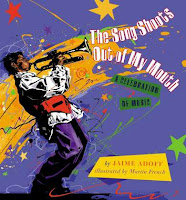 Song Shoots Out of My Mouth
Song Shoots Out of My Mouth, written by Jaime Adoff and illustrated Martin French, is a collection of twenty four poems that reflect a variety of musical styles and instruments in content and form. The poems sing with the same rhythms you would expect to hear in the music. They are perfect for read aloud and almost demand to be sung, or swung, tapped, rapped, drummed, and more. Here is a poem related to jazz.
Jazz Bath
Be Bop bubbles go
up my nose and I blow into my horn.
Pass the soap and the eighth notes, drip
into my eyes.
No more tears
no more fears.
My sax speaks for me. Says what I can't say. Which is a lot
these days. Now, teenage.
I trade 4's and 8's with Bird and Trane.
Outside my bathroom door;
I hear the roar of the crowd,
the roar of the crowd!
The roar of my sister screaming,
"GET OUT!"
Poem ©Jaime Adoff. All rights reserved.
The back matter for this book includes a section called
Backnotes which includes musical terms and descriptions, as well as an overview of selected artists and suggested listening material. If you haven't seen this one, you're really missing something special. (If you didn't know it, this book was named an honor book for the
Lee Bennett Hopkins Poetry Award in 2003.)
 Sweethearts of Rhythm: The Story of the Greatest All-Girl Swing Band in the World
Sweethearts of Rhythm: The Story of the Greatest All-Girl Swing Band in the World, written by Marilyn Nelson and illustrated by Jerry Pinkney, is the story an all-female, racially integrated swing band that toured the United States during World War II. What makes this story unique is that it is told in poems, each in the voice of a band members’ instrument, each titled after a song of the era. It all begins
I love poems that introduce and explore places, particularly places I've never been. Here are some books that explore America in poetry.


Home to Me: Poems Across America, selected by Lee Bennett Hopkins and illustrated by Stephen Alcorn, is described this way in the Editor's Note (written by Lee).
Where we live—the place we call home—strongly influences our way of life.
Whether on lives on a prairie where a child ". . . pedals through grasses/bone dry, needle thin", a reservation where "Mother Earth is always beneath our feet", or a city where one wakes up to hear "sputters/of sweepers/swooshing litter/from gutters", home is an integral part of growing up, being, becoming.
.
.
.
Home to Me reveals home and heart, the pulse that makes our country so unique—the beat that makes us all individuals—yet one.
This particular anthology is comprised of 15 commissioned works by poets from across the U.S., including Jane Yolen, Rebecca Kai Dotlich, Tony Johnston, Janet Wong, Ann Whitford Paul, Joan Bransfield Graham, Alice Schertle, Joseph Bruchac, and others. There are poems here about home in the desert, the prairie, the New Jersey shore, the mountains, a reservation, a cattle ranch, a farm, and more. Here is an excerpt from one poem.
My Desert Home
Here on Table Mesa
I look down on endless sand
That seems to spread forever
Over barren lonely land.
My home is on the stony ridge
Of a prehistoric sea
Where brittle bushes shine their gold
In shade of a single tree.
A cactus like a one-armed man
Is pointing to the sky.
Poem ©Lillian M. Fisher. All rights reserved.
, selected by Lee Bennett Hopkins and illustrated by Stephen Alcorn, is a collection of 50 poems grouped by geographic region. It includes the northeast states, Capital, southeast states, Great Lakes states, plains states, mountain states, southwest states, and Pacific coast states. The section for each region is prefaced with a map and facts about each state, including capital, nickname, motto, bird, flower, tree, area, and one "great fact." Here's a poem from the Pacific coast region.
California Missions
They're tall and sturdy,
four feet thick,
built of stone
and mortar, brick.
Through quakes and plagues
each ancient wall
has stayed in place
and stood up tall.
No mouth to speak,
no ears to hear,
yet they hold tales
of ancient years.
I sit inside
and listen well
to every word
their silenc
Several years ago while looking for some bilingual poetry for a student teacher, I stumbled across the book
Iguanas in the Snow and Other Winter Poems / Iguanas en la nieve: y otros poemas de invierno, written by Francisco Alarcón and illustrated by Maya Christina Gonzalez. The vibrant art on the cover reeled me in, and once I was inside the magic of the poems enchanted me. Here's one I suggested she use with her ESL students, all recent immigrants, all Spanish-speaking.
Ode to Buena
Vista Bilingual School
here Spanish
goes to school
with English
uno-dos-tres
is as easy as
one-two-three
here children
of all races write
beautiful poems
in English
and Spanish
even in spirals
and following
the beat of teacher
Felipe's clave
here children
learn to sing
with their hearts | Oda a la Escuela
Bilingüe de Buena Vista
aqui el español
va a la escuela
con el inglés
uno-dos-tres
es tan fácil como
one-two-three
aqui niños de todas
las razas escriben
bellos poemas
tanto en inglés
como en español
hasta en espiral
y siguiendo
la clave del
maestro Felipe
aqui los niños
aprenden a cantar
con el corazón |
Poem ©Francisco Alarcón. All rights reserved.
<
Poems that take shape are so much fun to read. What is a concrete poem? On his web site
John Grandits says that "Concrete poems are poems that use fonts, and shape, and texture, and color, and sometimes motion."
In the last few years, many new concrete poetry books have been added to my list of favorites. I'm going to share a few here. Keep in mind that concrete poetry is about the marriage of words and form. Therefore, you need to SEE them to truly appreciate them. That means this post will have lots of links to sites where you can see the art in these poems.
A Curious Collection of Cats (2009) and its follow-up,
A Dazzling Display of Dogs (2011), both written by Betsy Franco and illustrated by Michael Wertz, are collections that explore the peculiarities and absurdities of cats and dogs in wildly energetic ways. First, just look at those covers! If the use of animals in forming the letters of the title don't immediately suck you in, then hopefully a few of these interior shots will. Michael Wertz has generously posted images from the books on his Flickr stream. Take a look at these images from
CATS and these from
DOGS.
Technically, It's Not My Fault (2004) and
Blue Lipstick (2007), both written and designed by John Grandits, are two collections designed for older readers. The first book is written from the point of view of a young boy named Robert. The poems reveal Robert's concerns with all things adolescent. He is at turns smart then immature. Poems topics include his older sister, th
On my regular travels through classrooms I have noticed that students are often asked to write acrostic poems. Sometimes I see their names or the topic they are studying as the spine of their poems. Too often these acrostic studies are merely lists of descriptive words or phrases. Poetry they are not. I think good acrostic poems are hard to write. To inspire students in their acrostic writing you need strong mentor texts they can use as models. The books that follow provide outstanding examples of acrostics that work.
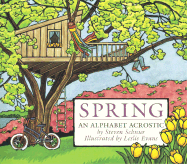 Spring: An Alphabet Acrostic
Spring: An Alphabet Acrostic, written by Steven Schnur and illustrated by Leslie Evans, is a collection of 26 acrostics from April to zenith. The poems each serve as a complete thought about the subject and are crafted exquisitely with what seem to be just the right words. Here are a few examples.
After days of
Pouring
Rain, the last
Ice and snow finally
Leave the earth.
Egrets, ducks and
Geese nest in the marsh
Grass, waiting for their
Shells to hatch.
Nestled under the
Eaves, a
Song-filled ark of
Twigs and grass.
Poems ©Steven Schnur. All rights reserved.
You'll also find poems for the words buds, calf, dawn, frog, grass, hopscotch, infant, jungle, kites, ladder, May, outside, parade, quintuplets, raft, seeds, twilight, umpire, Venus, wheat, Xing, and young.
All four books in this series are equally strong and beautifully illustrated. You can view some of Evans' illustrations in the series, as well as read some of the poems they accompany at the
Picture Book Directory of Children's Illustration. Using Google Book Search you can also view samples from
0 Comments on Poetry in the Classroom - Amazing Acrostics as of 1/1/1900
I've got food on the brain today, so food poetry it is!
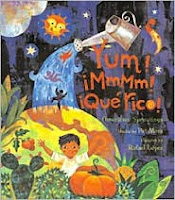 Yum! ¡Mmmm! ¡Qué Rico!: America's Sproutings
Yum! ¡Mmmm! ¡Qué Rico!: America's Sproutings, written by Pat Mora and illustrated by Rafael López, is a book that combines factual information about edible plants native to the Americas with crisp, sense-filled poems all in the form of haiku. (HAIKU! This title should have made my
Just Haiku post!) Kids reading this book will be hungry to try out some of the foods so deliciously described. Here is one of the poems and informational text that accompanies it.
Cranberries
Marsh-floating hard bead
simmers then POPS! in hot pot.
Scarlet fireworks.
Cranberries are tart fall fruits. They may be native to Wisconsin, where about half of the United States crop grows on woody, trailing vines in sandy marshes or bogs. The berries were used by Native Americans for food, dyes, and medicines. Some say they were called cranberries because cranes liked to slosh through the bogs looking for a bright red snack. Others say they were called cranberries because their pink spring flowers look like a crane's head. These fruits were also called bearberries and bounceberries. Can you guess why?
Poem and text ©Pat Mora. All rights reserved.
Though neither are in print today, I cannot fail to include these titles in this post.
Let's start with the "introduction" to
Chocolate Dreams (1988), written by Arnold Adoff and illustrated by Turi MacCombie.
Dear Reader:
We will be watching very lovingly to make sure that no on licks any of these pages, bites the binding, or chews the covers of this chocolate book.
Once you have finished some sweet pieces, get up and go to some room or store. Visit very full refrigerators. Get something c h o c o l a t e to stuff in your mouth. Then come back to this book and read some more. The best way to read this writing is by biting and chewing in unison (all together now) with these delicious words.
 First Food Fight This Fall: And Other School Poems
First Food Fight This Fall: And Other School Poems, written by Marilyn Singer and illustrated by Sachiko Yoshikawa, follows a group of children as they learn and grow over the course of a school year. These poems are written in the children's voices and fairly sing about the highs and lows of school. What's most interesting is that readers will see how the kids grow and change over the course of the year. Here are two poems that show this growth.
The Class I Hate
by Fumi
A-tisket, a-tasket,
don't wanna shoot a basket,
or join a baseball team,
or walk the balance beam.
Would I care to climb a rope,
run, or tumble? One word: nope!
I don't even like to swim.
Guess what class I hate.
It's gym!
The Class I Love
by Fumi
Hickory, dickory, dock,
hurry up, hurry up, clock!
I want the time to pass
so I can get to class.
Here's the crazy thing:
I can cha-cha, rumba, swing,
do merengue, salsa, too.
There's no dance that I can't do.
Yes, I know what I once said.
But now I love, love, LOVE Phys. Ed.!
Poems ©Marilyn Singer. All rights reserved.
 Stampede!: Poems to Celebrate the Wild Side of School
Stampede!: Poems to Celebrate the Wild Side of School, written by Laura Purdie Salas and illustrated by Steven Salerno, is a collection of poems that recognizes and celebrates the ways kids mimic the behaviors of animals. The poems are funny, clever, and clearly recognize the ups and downs of being a kid. Here is one of my favorites.
Nesting
While many poetry collections include a variety of forms, I am somewhat partial to those that focus on a particular form. There are several wonderful titles written entirely in haiku.
 Black Swan/White Crow
Black Swan/White Crow, written by J. Patrick Lewis and illustrated by Christopher Manson, is a collection of 13 poems accompanied by woodcut illustrations. The words and images are spare and beautiful, fully complementing each other. In the introduction, Lewis describes the form and encourages readers to write their own haiku.
To write a haiku, you might go for a walk in a city park, a meadow, the zoo. Put all your senses on full alert. Watch. Listen. Imagine that what you are seeing or smelling or hearing has never been seen, smelled, or heard before--and may never be again. Now take a picture of it--but only with your words.
The best haiku may you think and wonder for a longer than it takes to say them.
I've always loved that last line. Here's one of the haiku I still think about, especially when I'm at the beach.
Frantic sandpiper--
high tides erasing
her footnotes
Poem ©J. Patrick Lewis. All rights reserved.
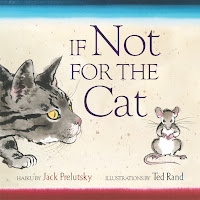
Hands-down my favorite work of Jack
Prelutsky's is
If Not For the Cat, illustrated by ted Rand. The seventeen haiku in this book encourage readers to see animals in new ways. Without sharing the illustrations these can be read as "Who am I?" poems. Can you guess which animals are described in these two poems?
Gaudily feathered
With nothing at all to say,
I can't stop talking.
Wingless we went in,
But we emerged as fliers--
And oh, such colors!
Poems ©Jack Prelutsky. All rights reserved.
 The Cuckoo's Haiku: and Other Birding Poems
The Cuckoo's Haiku: and Other Birding Poems, written by Michael J.
Rosen and illustrated by Stan Fellows, uses haiku to introduce a range of birds by season. Looking much like a field journal, this beautifull
I love poetry that gives me a glimpse of life in other places, but I also like the affirmation that comes from knowing others so far away may not be so different from me. Here are two books that bring these other voices to life.


This Same Sky: A Collection of Poems from around the World, selected by Naomi Shihab Nye, is a collection of poems in a range of styles from sixty-eight countries. The poems are divided into six sections
--Words and Silences,
Dreams and Dreamers,
Families,
This Earth and Sky in Which We Live,
Losses, and
Human Mysteries. Here are two of my favorite poems, both from the section
Human Mysteries.
Debt
by Sunay Akin (Turkey)
translated by Yusuf Eradam
I used to drop my pocket money
into the rain grates by the road
taking them for piggy-banks--
that's why it's the sea
that owes me most
Jerusalem
by Yehuda Amichai
translated by Stephen Mitchell
On a roof in the Old City
laundry hanging in the late afternoon sunlight;
the white sheet of a woman who is my enemy,
the towel of a man who is my enemy,
to wipe off the sweat of his brow.
In the sky of the Old City
a kite.
At the other end of the string,
a child
I can't see
because of the wall.
We have put up many flags,
they have put up many flags.
To make us think that they're happy.
To make them think that we're happy.
The book ends with notes on the contributors, a world map showing their locations (centered on Eastern Russia, Japan and Australia--a very interesting way to view the world that for us is so often centered on North America), and suggestions for further reading. Readers will also find an index for countries and one for poets. This is a wonderful collection that will allow readers to see how varied cultures are both distinguished and united under one sky.
The Tree is Older Than You Are: A Bilingual Gathering of Poems & Stories From Mexico, selected by Naomi Shihab Nye and illustrated with paintings by Mexican artists, is an amazing collection from a wide range of Mexican writers. Here is an excerpt from the Introduction.
Now I live in one of the most Mexican of U.S. Cities, in an inner-city neighborhood where no dinner table feels complete without a dish of salsa for gravity, and the soft air hums its double tongue

It's the weekend and that means it is time for another thematic list. This week I'm tackling some doggone good poetry. (Sorry, I just couldn't help myself!) I promise I'll give equal time to cats in the next list, though you will find that a few of these titles include both dogs and cats. I'm starting not with a book, but a single poem by Valerie Worth, illustrated here by my son.
Good Dog, written by Maya Gottfried and illustrated by Robert Rahway Zakanitch, is a collection of free verse poems in which 16 breeds express their personalities.
It's About Dogs, written by Tony Johnston and illustrated by Ted Rand, is a collection of more than 40 poems that pay tribute to man's best friend.
A Dazzling Display of Dogs, written by Betsy Franco and illustrated by Michael Wertz, is a series of 34 concrete poems that illustrate a variety of dogs in a range of situations doing things like riding in the car, escaping from home, chasing their tails, and more.
Stella, Unleashed: Notes From the Doghouse, written by Linda Ashman and illustrated by Paul Meisel, is a book of poems told from Stella's point of view. They cover topics as varied as her rescue from the pound, selecting a name, the family members, other pets, eating, sleeping, the dog park, and more.
Dogku, written by Andrew Clements and illustrated by Tim Bowers, is the story of a stray dog told through a series of 17 haiku.
Dog Poems, written by Dave Crawley and illustrated by Tamara Petrosino, contains 24 rhyming poems that de
Do you suffer from entomophobia or insectophobia? If so, then this post for you! There is no better way to overcome your fear of the little critters than to look over some amazing images and read a bit of poetry about them! (Well, okay, actually holding a cockroach, walking stick, or beetle in your hand might help, but my blog just doesn't have that power--yet!)
Let's start with a favorite poem from
Insectlopedia, a collection of poems written and illustrated by Douglas Florian.
The Praying Mantis
by Douglas Florian
Upon a twig
I sit and pray
For something big
To wend my way:
A caterpillar,
Moth,
Or bee--
I swallow them
Religiously.
Poem ©Douglas Florian. All rights reserved.
I have long been a fan of Florian's poems and artwork. The poems are often irreverent and play upon words in unusual and sometimes surprising ways. They are accompanied by vibrant watercolors that enhance the subtext of the poems. For example, the illustration of the mantis shows it affixed to a branch feeding on a moth. On that branch is a prayer book. It's a clever piece and utterly delightful.
Here's what Douglas had to say about his writing and artwork in this book.
In INSECTLOPEDIA I primed brown bags with white gesso, then painted insects on those bags with watercolors, using a very fine sable brush. Afterward I cut and pasted and flipped and flopped pieces of those pictures and added medieval lettering. I love to give a shape to a poem if it makes sense. My poem about a sawfish is in the shape of a saw. My inchworm poem arches like an inchworm.
Excerpted from Embracing the Child: Meet Douglas Florian.
There are 21 poems and illustrations in this book, 19 of them about insects and two about spiders. Readers will find poems about the caterpillar, dragonfly, army ants, walkingstick, hornet, termites, crickets and more in this collection.
Since I've already shared one praying mantis poem, let's look at another. This one comes from the wickedly funny book
The Little Buggers: Insect & Spider Poems, written by J. Patrick Lewis and illustrated by Victoria Chess.
I thought that at least once a week during this trek through April it might be helpful if I put together a thematic list of poetry titles. Since math and poetry are two of my favorite things, this seems like a great place to start.
Arithme-Tickle: An Even Number of Odd-Riddle Rhymes, written by J. Patrick Lewis and illustrated by Frank Remkiewicz - These 18 rhyming riddles present word puzzles to be solved. Answers are written upside-down below each entry.
Mathematickles!, written by Betsy Franco and illustrated by Steven Salerno - This book offers brief poems using forms suggested by mathematical processes, all within a seasonal framework changing from fall to winter to spring to summer. As it says on the cover, "words + math + seasons =
Mathematickles!"
One Leaf Rides the Wind, written by Celeste Davidson
Mannis and illustrated by Susan Kathleen
Hartung - This book is set in a Japanese garden where a young girl counts the things she sees, like bonsai,
koi, and lotus flowers. The left side of each spread contains an illustration of the objects being counted. On the right side of each spread is the printed numeral, a haiku describing the objects, and a footnote introducing readers to various aspects of traditional Japanese culture.
1 Comments on Poetry in the Classroom - Math and Poetry, last added: 4/4/2011
My son is enamored of dragons. With this love comes an interest in all things knightly. He builds castles and catapults, wields a plastic sword like a knight of old, and longs to visit a castle one day. Medieval times are often viewed through a romantic lens by children today, but the time was anything but an easy one for most people. There are many great pieces of historical fiction that accurately describe the hardships of medieval life, but poetry can do this too!
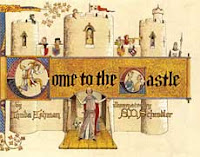 Come to the Castle: A Visit to a Castle in Thirteenth-Century England
Come to the Castle: A Visit to a Castle in Thirteenth-Century England, written by Linda Ashman and illustrated by S.D. Schindler, is a fun, witty and thoroughly educational look at the past. The Author's Note in the back of the book is where I'm going to start and where you should start while reading aloud.
Several years ago, I became curious about life in the Middle Ages. In particular, I wondered what it might have been like to live in a castle at that time. As I focused my research on thirteenth-century England, distinct characters began to emerge in my mind: a wealthy but dim-witted lord; his overworked steward; his beleagured staff; his intelligent daughter, forced to endure the attentions of various unappealing suitors. These characters are fictional, of course, and I've taken some poetic license for the sake of humor an drama (for example, the planning and execution of the tournament is compressed into a matter of days). Still, in writing these poems, I've tried to give a fairly accurate glimpse of castle life during this period.
Readers meet a cast of twelve characters, beginning with The Earl of Daftwood. His poem sets the stage for the action and introduction of folks who live and work in the castle. To remedy the tedium that is his life, he commands his steward to plan a tournament.
The Steward
Steward, plan a tournament?
The Earl is surely daft!
Though he has countless servants,
I am vastly understaffed,
Overworked, and truly weary
Of his constant recreation
(Oh, how I'd love a nice massage
and several weeks' vacation!)
Next, the herald heads off to deliver the invitation.
A Feast at Daftwood Castle--
Lord and Ladies, come and dine!
We'll keep you fed and entertained
And plied with ale and wine.
We promise jousts and dancing
(And perhaps a messy brawl).
A guarantee of revelry--
Come join us, one and all!
Preparations are made by the lady of the castle, while the cook begins to prepare the feast, The the cleaning servant prepares the hall and the dishes, while the gong farmer cleans the privy.The knight prepares for battle, and once the guests arrive he engages in the joust. The meal is eaten, the jester performs, and all hell breaks loose before the dancing begins. The following day the doctor checks on their aches and pains.
The source of their illness?
A monkey could guess:
They stuff themselves silly and drink to excess.
But it is my duty to see them to health--
And, frankly, it adds to my b
Last year during the month of April I noticed that my son was writing poems in his class journal. When I asked why he told me that he was listening to his teacher read
Love That Dog and that as part of the experience she had encouraged the students to find and write poems in their journal. This was my son's first entry.
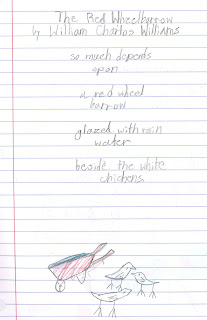
I was not surprised to see
The Red Wheelbarrow. My son does share the author's name (William), and that's a big deal for a kid, so that may have been a motivating factor. However, it is the first poem in the book that Jack talks about. Here's what he had to say.
Excerpt from Love That Dog
by Sharon Creech
September 27
I don't understand
the poem about
the red wheelbarrow
and the white chickens
and why so much
depends upon
them.
If that is a poem
about the red wheelbarrow
and the white chickens
then any words
can be a poem.
You've just got to
make
short
lines.
It only makes sense that a child reading or hearing this would wonder about the poem and might want to learn more. When I asked William why he chose the poem, he simply stated that he liked it, even though it didn't rhyme.
I suppose we could ask that question of any poem. Why do you like it? It's such a personal question and the answers are nearly as varied as the poems themselves. I like this poem for its economy, the rhythm of the words as they roll off my tongue, and for Williams' ability to make something ordinary so very extraordinary.

I think Williams is a perfect poet to introduce to students because of the visual imagery in his poems and his mastery of language. While I love
The Red Wheelbarrow, I'm equally fond of
Blizzard,
Between Walls,
Metric Figure, and
Winter Trees, all poems that could easily be shared in the classroom.
Williams is a fascinating study, and no teacher introducing his poetry should be without the wonderful picture book biography
A River of Words: The Story of William Carlos Williams, written by Jen Bryant and beautifully illustrated by Melissa Sweet. (If you are interested in using this book in the classroom you can download a very helpful
View Next 14 Posts


























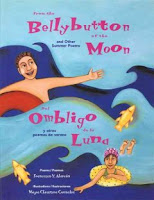

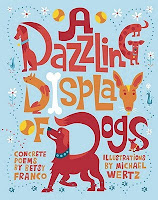
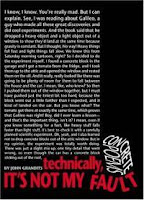























Wonderful post! I grew up with lots of poetry (my dad made me start memorizing it when I was three!) so I'm always surprised when my peers don't like it--and they almost invariably say it's because it was never read to them when they were young. Reading poetry to my girls is one of my favorite things to do as a parent now, and they're already in love with it, too.
I remember reading AA Milne to my now twelve-year-old when he was really little. He'd thump to the rhythm. Poetry is a wonderful way to expose children to new ways words work together, to lovely imagery and rhythms and textures.
It has a need to fill and is a pleasure.
Truly enjoying browsing today. And laughing my head off at this disk jockey/ car salesman/ baseball player turned poet. Thank you, Caroline, for all of these posts.
My pleasure! The variety really has been fun.